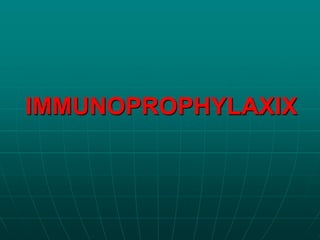
Immunoprophylaxis(1)
- 2. Immunoprophylaxix Protection against infectious diseases by (immunization) acquired by the individual either passively or actively: I- Passive acquired immunity II- Active acquired immunity
- 3. I- Passive acquired immunity Ready made Ab transferred to individual giving rapid protection and short lasting immunity: a-Naturally acquired passive immunity Occurs when antibody are transferred from mother to fetus (IgG ) or in colostrum (Ig A). b- Artificially acquired passive immunity Short-term immunization by injection of antibodies, For examples: - injection of antitoxic serum for treatment of diphtheria or tetanus. - injection of gamma globulin that are not produced by recipient's cells, to hypogammaglobulin children .
- 4. II- Active acquired immunity Individual actively produces his own Ab. Immunity develop slowly and long lasting due to development of immunological memory: a-Natural active acquired immunity The person becomes immune as a result of previous exposure to a live pathogen b-Artificially active acquired immunity A vaccine stimulates a primary response against the antigen without causing symptoms of the disease.
- 5. Vaccination -immunity against pathogens (viruses and bacteria) by using: live attenuated killed altered antigens that stimulate the body to produce antibodies -Vaccines work with the immune system's ability to recognize and destroy foreign proteins (antigens)
- 6. Vaccination Vaccination prevents and control such diseases as cholera, rabies, poliomyelitis, diphtheria, tetanus, measles, and typhoid fever Vaccines can be: a- prophylactic (e.g. to prevent or ameliorate the effects of a future infection by any natural or "wild" pathogen b- Therapeutic (e.g. vaccines against cancer are also being investigated
- 7. Types of vaccines: 1-Killed vaccines: Virulent bacteria or viruss used to prepare these vaccines may be killed by heat (60 °C) or by chemicals (formalin, phenol or merthiolate), examples: a-TAB vaccine against entric fever (heat) b-Salk vaccine against poliomylitis (formaline) c-Semples vaccine against rabies (phenol) d-pertussis vaccine against whooping cough (merthiolate)
- 8. Types of vaccines: Killed vaccine are: Do not stimulate local immunity Short lasting Do not stimulate cytotoxic T cell response in contrast to live attenuated vaccines safe can be given to pregnant woman and immunocompromised host It is heat stable
- 9. Types of vaccines: 2-live attenuated vaccines: - living m.o lost its virulence so do not produce disease but produce immunity. -stimulate both humoral and cell mediated immunity, local and systemic. -not given to pregnant women and immunocompromised hosts (may cause diseases) -heat unstable
- 10. Types of vaccines: - It is prepared by: a-repeated subculture in unsuitable condition (chemical or media) e.g BCG vaccine against T.B and 17 D vaccine against yellow fever. b-growing at high temp. (above optimum temp) e.g Pasteur anthrax vaccine c-selection of mutant strains of low virulence e.g Sabin vaccine against poliomylitis.
- 11. Types of vaccines: 3- Toxoids - It is prepared by detoxifying bacterial toxins. - bacterial exotoxins treated by formalin to destroy toxicity and retain antigenicity - e.g.diphtheria and tetanus toxoid.
- 12. Types of vaccines: 4- Microbial products vaccines are prepared from bacterial products or viral components e. g: a-Capsular polysaccharide vaccines are: - Poor immunogen in children below 2 years age e. g H. influenza -do not respond to T cell independent antigens inspite of its generation of Ig M -produce anticapsular opsonizing antibodies -examples meningiococci, pneumococci and H. influenza b-cellular purified proteins of pertussis c- purified surface Ag of hepatitis B virus d-influenza viruses
- 13. Types of vaccines: prepared by recombinant DNA technology for improvement vaccines e.g: a- subunit vaccines in which microbial polypeptides are isolated from the infective material hepatitis B and influenza viruses B- Recombinant DNA-derived antigen vaccines: in which Ag are synthesizing by inserting the coding genes into E. coli or yeast cell as HBV vaccines C- Recombinant DNA avirulent vector vaccines: in which the genes coding for the Ag is inserted into genome of an avirulent vector such as BCG vaccine D-Synthetic peptide vaccines: synthesis of short peptides that corrospond to antigenic determinants on a viral or bacterial proteins e.g cholera toxins and poliovirus to produce Ab response.
- 14. Combined immunization (Vaccination) -Immunization against diseases is recommended in combination (for young children) as : diphtheria, tetanus (lockjaw), and pertussis (whooping cough), given together (DTP). measles, mumps, and rubella, give together as MMR Haemophilus influenzae b (Hib) with DTP influenzae b (Hib) with inactivated poliomyelitis vaccine (IPV) influenza; and Neisseria meningitidis (meningococcal meningitis).